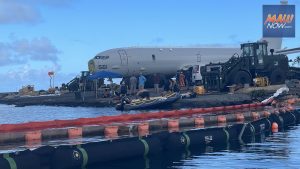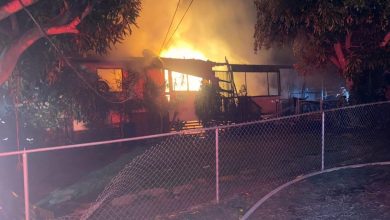Divers begin coral reef assessment after salvage of Navy aircraft from Kāneʻohe Bay : Maui Now

[ad_1]

Dive teams completed a second day of coral reef damage assessment after a P-8A Poseidon aircraft slid off the end of the runway at Marine Corps Base Hawai‘i last month.
The US Navy deployed three booms to contain any possible fuel leakage from its plane, and used anchor points to hold the booms in place. The majority of the 30 anchor points were impacting coral, according to the state Department of Land and Natural Resources.
Navy divers were advised on best management practices, as they began removing the boom anchors, to try and minimize any additional damage.
Kim Fuller, the DLNR Division of Aquatic Resources biologist leading the state team, said that during their 2 ½ hours of dive time Sunday they were able to delineate the majority of the initial impact area. Today, crews were finishing up work to delineate the impact site within the inner-most boom.
“The major impact area, at this point, is pulverized coral,” Fuller said. Closer to shore, at the end of the runway, coral colonies have a multitude of white scars. Tops of corals are sliced off where the plane’s landing gear first struck, or during its salvage.
“Due to the habitat, we feel that overturning corals immediately will be the best restoration option, and that’s what we plan to do. Some of the fragments are quite small and in other places colonies were toppled or had large chunks broken off. Normally we would reattach coral colonies in place, but those are areas where there’s solid substrate on which to attach them. Where the plane impacted it’s a mixture. There are solid coral areas adjacent to shore, some sand further out, and then it’s a mixed rubble, coral, sandy habitat,” Fuller explained.
According to DLNR, biologists usually need four to five days in the water to conduct a full assessment of a boat grounding or other impacts to reefs, like the P-8A accident. MCBH has scheduled additional time on Tuesday for continuing the assessment.
The most recent coral damage incident that Fuller worked on was the dragging of an anchor chain over coral colonies in Honolulu Harbor. Asked to compare that case with this one, she said, “The footprint of that area was much larger, but the coral density was much lower. In the bay the footprint is smaller, however the coral density is higher. We want to do all we can to give the damaged corals better chances for survival.”
Fuller and her federal counterparts are documenting their findings in written reports.
[ad_2]
Source: Maui News




